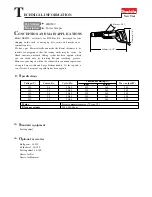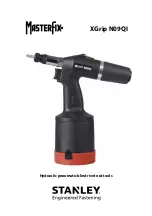
6
OPERATION
Operation
CLAMPING
1. Check that the moving
jaw locking tab (11) is
set to the horizontal
position and push the
moving jaw (1) back
until your workpiece
fits between the jaws.
2. Place the workpiece against the fixed jaw
(2) and slide the moving jaw forward until it
touches the workpiece.
The jaw can also be advanced forward by
pressing the foot pedal repeatedly.
3. Slide the lock / release switch (4) down to the
“lock” position.
If preferred the switch can be locked
after the work is clamped.
4. Apply downward
pressure on the
foot pedal (5) until
sufficient clamping
force has been applied.
For extra force you may stand on the foot
pedal (maximum 100kg) but do not jump
on it, as you could damage the unit.
RELEASING
1. Slide the lock/release switch (4) up to the
“release” position.
2. Push on the foot pedal then allow it to return
up and release the workpiece.
Ensure you are supporting the workpiece
to prevent it from falling once the jaw is
released.
If you have clamped the object very
tightly, you may need to exert more
pressure on the foot pedal before it will
release.
3. Slide the moving jaw back and remove your
workpiece.
CLAMPING ON ONE SIDE OF
THE JAW
On occasions, large or awkward workpieces can
only be clamped on one side of the jaws.
Always fit a spacer (the same thickness as your
workpiece) to the other side of the jaws, to
prevent the moving jaw from skewing.
CLAMPING LARGE OBJECTS
(460mm to 956mm)
The moving jaw can be reversed to
accommodate workpieces greater than 460mm
and less than 956mm.
1. Set the lock / release
switch (4) to the
“release” position and
ensure that the foot
pedal is released.
2. Check that the moving
jaw locking tab (11)
is in the horizontal
position.
3. Slide the moving
jaw (1) fully from
its tracks.
Summary of Contents for CMT200
Page 37: ......
Page 38: ...www cmtutensili com...







































